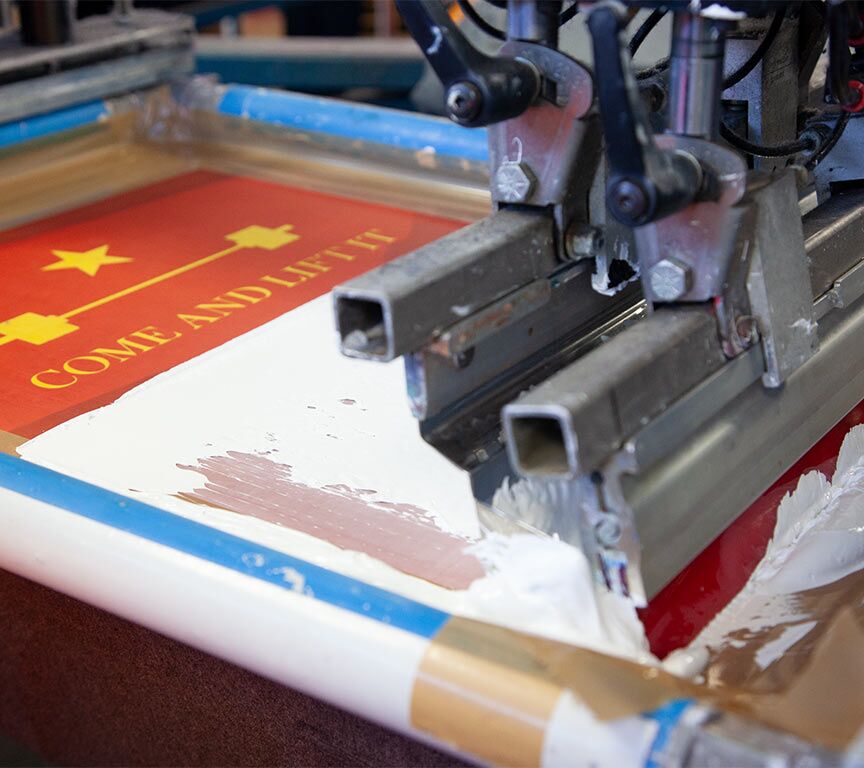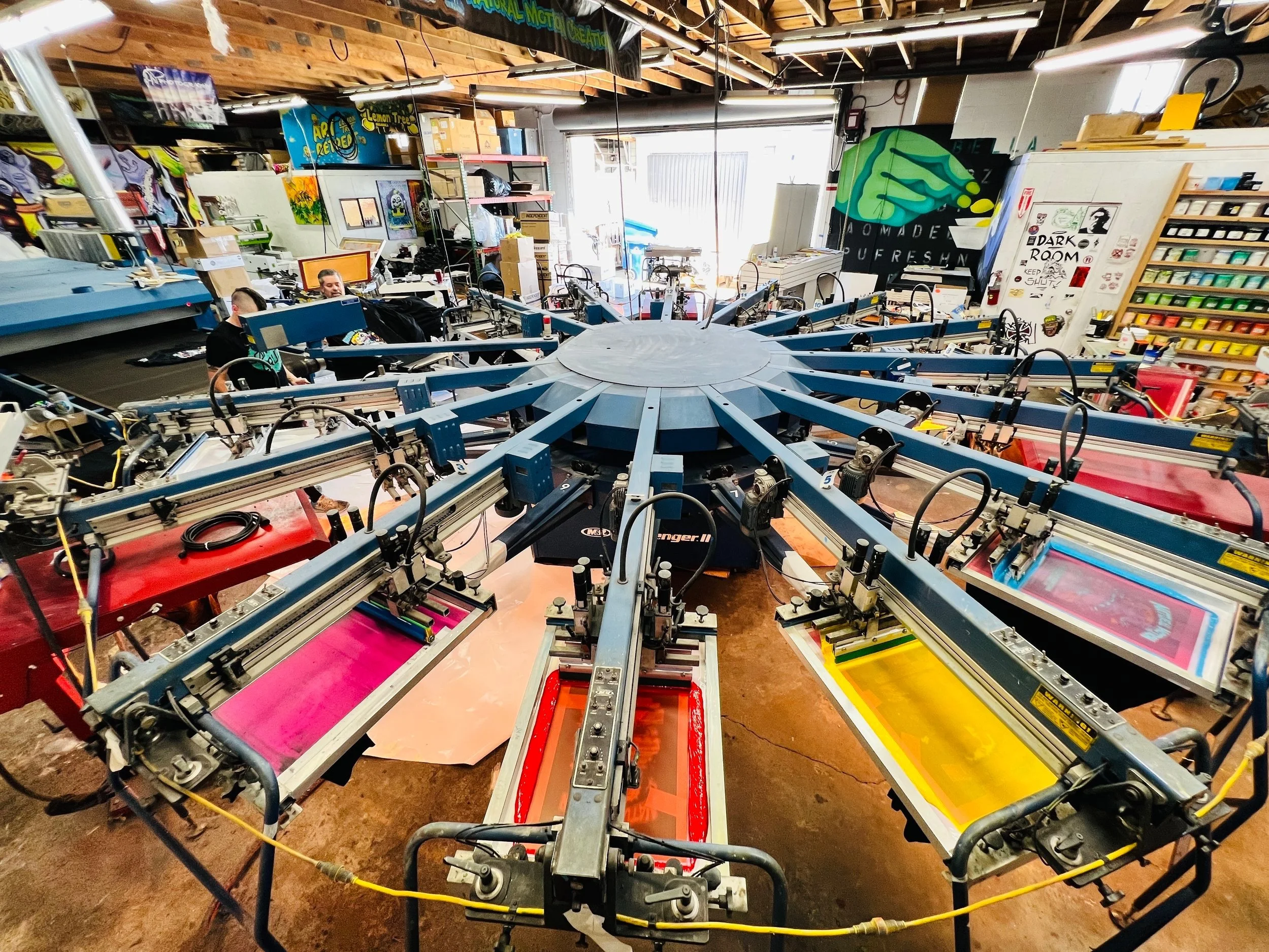Eco-Friendly Custom Screen Printing Options Available
Wiki Article
Screen Printing Uncovered: Every Little Thing You Need to Know Regarding Tee Shirt and Garment Printing Strategies
If you have actually ever questioned exactly how those vivid designs finish up on your favored tees, you remain in the right area. Display printing is a fascinating technique that integrates art with method, supplying countless possibilities for creativity. Understanding the basics, from equipment to ink choices, can significantly influence your results. All set to check out the vital components that make display publishing an art kind? Let's reveal the information that can boost your tasks.
The Essentials of Screen Printing: How It Works
When you plunge into screen printing, you'll uncover it's both an art and a scientific research. At its core, display printing includes producing a pattern, or screen, that allows ink to pass through only in certain areas (screen printing kit). You start by choosing your style and preparing your screen with a light-sensitive solution. As soon as you reveal this solution to light, it solidifies, leaving your layout as an unfavorable room.Following, you'll mix your inks and prepare your printing surface. Position the screen over the material, after that use a squeegee to press ink with the screen onto the garment. This process calls for accuracy, as you desire clear, dynamic prints. After printing, you'll heal the ink with heat, ensuring it complies with the fabric and lasts through laundries. Each step is crucial, and grasping them will certainly raise your display printing skills, transforming simple garments right into unique, expressive items.
Sorts Of Display Printing Strategies
As soon as you understand the basics of screen printing, it's time to discover the different techniques that can elevate your styles. One popular technique is conventional display printing, where ink is pushed through a stenciled screen. This technique is fantastic for bold, vivid colors. There's water-based ink printing, which offers a softer feeling and is eco-friendly, yet it calls for a different technique to healing.An additional choice is plastisol printing, known for its resilience and brilliant colors, making it a preferred for lots of brands. Experiment with halftone printing to create gradient results and detailed layouts.
Vital Equipment for Display Printing
To attain spectacular lead to screen printing, having the right devices is essential. First, you'll require a strong screen printing frame, which holds the mesh that moves your design onto the garment. Next, invest in high-quality squeegees; these are vital for using ink equally throughout the screen. You'll additionally call for a good exposure device to create your displays, along with a washout cubicle for cleansing them after use. A reputable warm source, like a conveyor clothes dryer or warmth press, is vital for curing your prints to guarantee long life. Don't neglect a correct work space, equipped with tables and storage for your materials. Lastly, safety gear, such as gloves and masks, will certainly keep you secure from chemicals and inks. With the right tools, you'll be well on your method to creating professional-quality prints.Picking the Right Inks and Products
When selecting inks and products for screen printing, you need to take into consideration the kind of ink that functions finest for your job. Think of material compatibility to guarantee your designs look terrific and last lengthy. Additionally, discover environmentally friendly ink alternatives to make your printing procedure much more sustainable.Sorts Of Display Inks
Choosing the right display ink is important for attaining dynamic, durable prints that meet your job's requirements. There are numerous kinds of screen inks to analyze. Plastisol ink is prominent for its versatility and simplicity of usage, providing outstanding color opacity on dark fabrics. Water-based ink, on the various other hand, uses a softer feel and is green, making it perfect for those aiming to lessen their ecological effect. Discharge inks get rid of color from the textile, leading to a soft, vintage appearance but need certain handling. Specialty inks, such as metallic or glow-in-the-dark, can add unique results to your layouts. Review your job requirements and select the ink that aligns finest with your wanted end result.
Material Compatibility Considerations
Recognizing material compatibility is vital for achieving top notch display prints, especially considering that different materials react distinctively to numerous inks. Always check your inks on example material to assure they stick properly and keep color stability. Additionally, keep in mind that material weight and structure can impact the last outcome, so picking the appropriate ink and product combination is essential for your project's success.Eco-Friendly Ink Options
Eco-friendly inks are coming to be a preferred choice for screen printers that want to lessen their ecological impact while maintaining quality. When picking inks, think about water-based inks, which are less harmful and much easier to cleanse up compared to traditional solvents.Furthermore, search for inks made from sustainable resources, such as soy or vegetable-based options. By selecting the best inks and products, you'll not just create spectacular layouts but also add to an extra lasting printing procedure. Make the switch, and your prints will reflect your commitment to the setting!
Preparing Your Style for Display Printing

Submit Layout Requirements
To assure your design looks sharp and vivid on fabric, you'll require to pay very close attention to file layout demands for display printing. Begin with vector files like AI or EPS, as they can be scaled without losing top quality. If you utilize raster pictures, go with high-resolution files, such as TIFF or PNG, ideally at 300 DPI. Prevent utilizing JPEGs, as they can lose clearness when resized. Additionally, ensure your layout has a transparent history to avoid undesirable white edges on your prints. Keep color modes in mind; CMYK is standard for display printing, so convert your RGB makes as necessary - screen printing kit. By following these guidelines, you'll set your artwork up for a successful print.Shade Splitting Up Strategies
Shade splitting up is an essential action in preparing your style for screen printing, and mastering it can greatly improve your print top quality. You'll require to break your style right into specific colors, as each shade needs a different display during printing. This precision not only ensures exact shade depiction but also simplifies the printing procedure.Resolution and Dimension
Achieving the very best cause display printing begins with guaranteeing your layout has the best resolution and dimension. Preferably, your artwork ought to go to least 300 DPI (dots per inch) for sharp, clear prints. If you use reduced resolution, your end product could look less than professional and pixelated.When it involves size, take into consideration the dimensions of your print area. Style your artwork to match the final print size, ideally developing it in the real measurements you'll be publishing. By doing this, you'll avoid any type of unexpected scaling problems.
Always check your design in both vector and raster layouts. Vector graphics can be scaled without losing quality, making them suitable for display printing. Preparing correctly will guarantee your style looks remarkable on every garment!
Step-by-Step Display Printing Process
Screen printing is a vibrant process that enables you to create lively layouts on numerous surface areas. To start, you'll need a display, solution, and your picked ink. First, prepare your display by cleaning it extensively. Next off, use the solution evenly and let it dry in a dark area. When dry, subject your screen to light with your style put on it, which will certainly solidify the solution where the light hits, developing a stencil - screen printing custom screen printing kit.After washing out the unexposed emulsion, your screen is all set. Set it up on your printing surface and align your garment under it. Put ink onto the display and make use of a squeegee to press the ink with the pattern onto the textile. Raise the display very carefully and allow the print dry. Ultimately, cure the ink making use of heat to guarantee longevity. That's it! You have actually effectively screen printed your style.
Tips for Successful Screen Printing Projects
While you're diving right into your display printing projects, bear in mind that preparation is crucial to success. Start by collecting all your materials-- inks, garments, mops, and screens. A clean office assists avoid undesirable errors, so clean up before you start.Next, validate your artwork is high-resolution and appropriately sized for your garment. Check your screen for proper direct exposure and clean it thoroughly to stay clear of spots. When mixing your inks, adhere to the maker's standards to accomplish the best consistency.
During printing, apply even stress with your squeegee for regular outcomes. Do not hurry; take your time to confirm each print meets your criteria. After printing, allow your garments dry totally prior to managing or packaging them.
Lastly, constantly keep an example of your work for future reference. In this manner, you can examine your progress and enhance your methods with time. Happy printing!

Regularly Asked Concerns
The length of time Does It Require To Establish a Screen Printing Work?
Establishing a display printing task commonly takes about 30 minutes to an hour. You'll prepare the displays, mix inks, and adjust journalism. The moment varies based upon complexity and experience, so remain arranged!Can I Print on Different Fabric Keys In Utilizing the Same Strategy?
Yes, you can print on various fabric kinds using the very same method, yet you'll need to readjust your inks and settings. Some textiles take in ink in a different way, so experimenting guarantees the very best results for each material.What Prevail Errors to Avoid in Screen Printing?
When display printing, stay clear of common mistakes like utilizing the incorrect ink, disregarding proper exposure times, or avoiding pre-press checks. Always evaluate your configuration and keep clean screens to guarantee top quality outcomes each time.Exactly How Can I Properly Clean and Keep My Display Printing Equipment?
To appropriately clean and maintain your display printing equipment, you need to frequently wash screens with proper solvents, check squeegees for wear, and ensure all devices are kept completely dry and dust-free. Uniformity protects against pricey repairs and boosts performance.Is Display Printing Eco-friendly Compared to Other Approaches?
Display printing can be much more ecologically friendly than various other techniques, especially if you utilize eco-conscious products and water-based inks. By choosing sustainable supplies and practices, you reduce waste and reduce your influence on the world.Screen Printing Uncovered: Every Little Thing You Need to Know Concerning Tee and Garment Printing Strategies
At its core, display printing involves developing a pattern, or screen, that permits ink to pass with only in certain areas. Placement the screen over the textile, after that make use of a squeegee to push ink through the screen onto the garment. One popular approach is typical display printing, where ink is pressed with a stenciled screen.When selecting inks and materials for display printing, you require to take right into account the kind of ink that functions finest for your task.
Report this wiki page